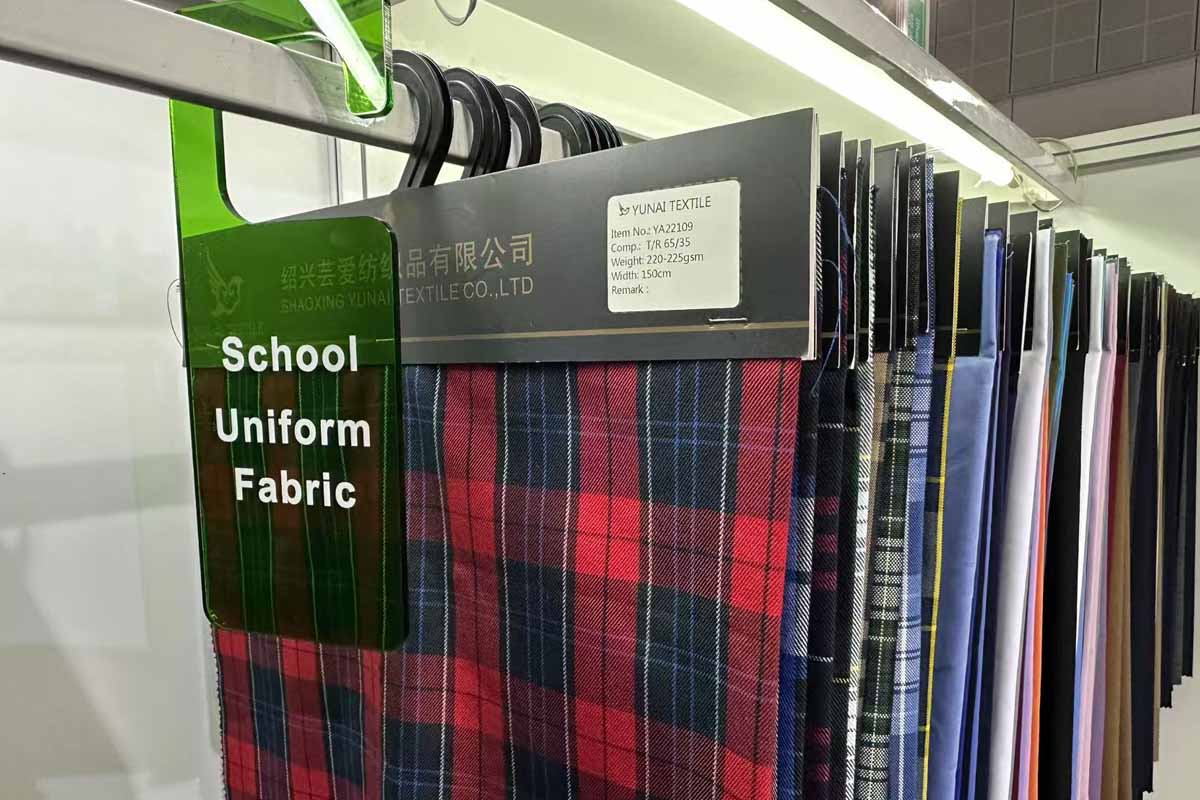Choosing the perfect school uniform fabric type is essential for achieving both functionality and style. Today’s school plaid fabric offers a blend of durability and eye-catching patterns, making it an ideal fabric for school uniforms. Thanks to innovations in textile technology, plaid fabric and other types of fabric for school uniform now feature moisture-wicking and stain-resistant properties, providing students with enhanced comfort and cleanliness.
Key Takeaways
- Pick strong fabrics for uniforms to handle daily use. Check for features like no pilling and scratch resistance to last longer.
- Choose fabrics that remove sweat and resist stains. This keeps students comfy and uniforms neat. It also helps with cleaning and staying healthy.
- Go for bright colors and special patterns that show school spirit. Custom designs help students feel proud and connected to their school.
Evaluating Fabric Quality
Importance of Durability in School Uniforms
Durability plays a critical role in the selection of school uniform fabrics. Students engage in various activities throughout the day, making it essential for uniforms to withstand wear and tear. Manufacturers evaluate durability using benchmarks such as pilling resistance, shrinkage control, and abrasion resistance. The following table highlights key durability tests:
| Durability Benchmark | Description |
|---|---|
| Pilling | Tests the fabric’s tendency to form small balls of fiber on the surface. |
| Shrinkage | Measures the fabric’s dimensional stability after washing. |
| Abrasion Resistance | Assesses how well the fabric withstands wear from friction. |
| Stretch and Recovery | Evaluates the fabric’s ability to return to its original shape after stretching. |
| Snagging | Checks for the fabric’s susceptibility to pulls and snags. |
Uniforms made from high-quality materials ensure longevity, reducing the need for frequent replacements and saving costs over time.
Comfort and Climate Suitability
Comfort is equally important when choosing school plaid fabric. Fabrics must adapt to various climates and provide students with ease of movement. Modern advancements in textile technology have introduced features like moisture-wicking properties for freshness, anti-microbial treatments for hygiene, and temperature-regulating materials for air-conditioned environments. Additional benefits include:
- Stain-resistant coatings for easy maintenance.
- Anti-static properties for added durability.
- UV-protected materials for outdoor activities.
These features ensure that students remain comfortable and confident, regardless of the weather or setting.
Advantages of 100% Polyester Yarn Dyeing Plaid Fabric
100% polyester yarn dyeing plaid fabric offers unmatched benefits for school uniforms. Polyester yarn is renowned for its durability, wrinkle resistance, and ability to maintain its shape, making it ideal for daily wear. The dyeing process enhances the vibrancy of colors, ensuring that the fabric retains its visual appeal over time. This fabric also simplifies maintenance, as it resists stains and requires minimal ironing. Schools seeking a balance between functionality and style often choose this fabric for its reliability and aesthetic versatility.
Designing Stylish School Plaid Fabric
Selecting Patterns That Represent School Identity
Patterns play a vital role in reflecting a school’s identity. A well-chosen plaid pattern can symbolize tradition, unity, and pride. Schools often opt for unique combinations of stripes, checks, or tartans to distinguish their uniforms. Customizing fabric patterns allows institutions to create a visual connection between students and their school community. Collaborating with a reliable plaid fabric supplier ensures access to a wide range of designs that can be tailored to specific requirements. This approach not only enhances the uniform’s aesthetic appeal but also fosters a sense of belonging among students.
Choosing Colors That Stay Vibrant Over Time
Color selection is crucial for maintaining the visual appeal of school uniforms. High-quality dyeing techniques, such as those used in 100% polyester yarn dyeing, ensure that colors remain vibrant even after repeated washes. Schools should consider hues that align with their branding while also factoring in practicality. For instance, darker shades may hide stains better, while lighter tones can evoke a sense of freshness. The durability of colors directly impacts the longevity of the uniform, making it essential to prioritize fade-resistant options.
Incorporating Modern Trends into Traditional Designs
Modern trends in textile design have transformed traditional school uniforms. Schools now integrate contemporary elements like vibrant color palettes, customization options, and inclusivity modifications into their designs. These trends not only enhance the uniform’s appeal but also improve student satisfaction. The following table highlights key trends and their impact:
| Trend Element | Impact on Student Satisfaction | Source of Evidence |
|---|---|---|
| Incorporation of plaid patterns | 30% increase | Recent study |
| Shift to vibrant color palettes | 40% decrease in discomfort | Survey |
| Customization options | 20% increase in enrollment | Statistics |
| Integration of technology | 15% increase in popularity | Tech magazine |
| Inclusivity modifications | 25% increase in positive feedback | Recent report |

By blending modern trends with traditional designs, schools can create uniforms that are both timeless and relevant.
Simplifying Maintenance and Care
Benefits of Stain-Resistant Fabrics
Stain-resistant fabrics simplify the maintenance of school uniforms by reducing the effort required to remove common stains. These fabrics feature advanced coatings that repel liquids and prevent dirt from embedding into the fibers. This innovation ensures that uniforms remain clean and presentable, even after a busy school day. Polyester blends, often used in school plaid fabric, are particularly effective due to their natural resistance to stains and ease of cleaning. By choosing stain-resistant materials, schools can provide students with uniforms that maintain their appearance with minimal upkeep.
Easy Washing and Ironing Tips
Selecting fabrics that are easy to wash and iron can save time and effort for both parents and students. Cotton-polyester blends and rayon are excellent choices for school uniforms. These fabrics resist wrinkling, retain their color, and withstand frequent washing without losing their shape. Polyester adhesive spinning fabric, for instance, offers anti-wrinkle properties, ensuring skirts and shirts look neat after washing. To maintain these fabrics:
- Use a regular washing machine with a gentle cycle.
- Avoid high heat during drying to preserve fabric integrity.
- Iron at a low temperature if necessary, though many polyester blends require minimal ironing.
These practices ensure that uniforms remain in top condition while reducing the time spent on maintenance.
Ensuring Longevity Through Proper Care
Proper care significantly extends the life of school uniforms, reducing the need for frequent replacements. High-quality fabrics, such as polyester blends, are designed to endure daily wear and frequent washing. Their durability minimizes wear and tear, ensuring uniforms last throughout the school year. Superior construction and fabric quality also contribute to longevity, saving parents money and reducing waste. To maximize the lifespan of uniforms:
- Wash them inside out to protect the outer surface.
- Avoid using harsh detergents that may weaken fibers.
- Store uniforms in a cool, dry place to prevent damage.
By following these care tips, schools and parents can ensure that uniforms remain durable and cost-effective.
Achieving Cost-Effectiveness
Balancing Price with Quality
Balancing price with quality is essential when selecting school plaid fabric. While budget constraints often influence decisions, investing in premium fabrics offers significant long-term benefits. High-quality materials may have a higher upfront cost, but their durability ensures better value over time.
- Premium fabrics resist wear and tear, reducing the need for frequent replacements.
- Their vibrant colors and structural integrity remain intact, even after repeated washes.
- Schools can save money by avoiding the recurring expense of replacing low-quality uniforms.
Collaborating with a reliable plaid fabric supplier ensures access to durable, cost-effective options. Schools can achieve a balance by prioritizing quality without compromising affordability.
Longevity as a Key to Saving Money
Longevity plays a pivotal role in reducing overall uniform expenses. High-quality school uniforms last longer, minimizing the need for replacements. Parents benefit from significant savings when uniforms endure daily wear and frequent washing.
- Quality fabrics require fewer repairs, lowering maintenance costs.
- Durable uniforms reduce waste, promoting sustainability.
Although the initial investment may seem higher, the long-term savings outweigh the upfront expense. Schools that prioritize longevity in fabric selection provide parents with a cost-effective solution.
Tips for Bulk Purchasing and Supplier Negotiations
Bulk purchasing and effective supplier negotiations can further enhance cost-effectiveness. Schools should consider the following strategies:
- Partner with a trusted plaid fabric supplier to secure competitive pricing.
- Negotiate discounts for large orders or long-term contracts.
- Request fabric samples to ensure quality before committing to bulk purchases.
Tip: Establishing a strong relationship with suppliers can lead to exclusive deals and priority service.
By implementing these strategies, schools can optimize their budget while maintaining high standards for their uniforms.
Practical Tips for Choosing the Best School Plaid Fabric
Requesting and Testing Fabric Samples
Testing fabric samples ensures that the chosen material meets the required standards for school uniforms. Schools should request samples from suppliers to evaluate their quality before making bulk purchases. Testing protocols in the textile industry provide a reliable framework for assessing fabric performance. The following table outlines key methods for sample testing:
| Testing Method | Description |
|---|---|
| Performance | Evaluates abrasion or pilling using Martindale or ICI tests. |
| Dimensional stability | Measures shrinkage, elongation, stretch, and recovery. |
| Weather testing | Assesses waterproof, windproof, and thermal properties. |
| Thermal and water vapor resistance | Tests permeability for comfort in various climates. |
| Burn test | Identifies 100% cotton textiles. |
| Seam strength | Examines durability of sewn articles. |
| Tearing strength | Tests penetration resistance. |
| Optical evaluation | Reviews appearance after care treatments. |
Schools can use these methods to verify the durability, comfort, and aesthetic appeal of the fabric samples. This step minimizes risks and ensures the selected school plaid fabric meets expectations.
Consulting with Experienced Uniform Suppliers
Experienced uniform suppliers play a crucial role in guiding schools toward the best fabric choices. Their expertise helps schools navigate the complexities of fabric selection, from pattern customization to material durability. Suppliers often provide insights into modern trends, cost-effective options, and maintenance tips. Schools should prioritize suppliers with a proven track record in delivering high-quality school plaid fabric.
Tip: Collaborating with a trusted plaid fabric supplier ensures access to tailored solutions that align with the school’s identity and budget.
Verifying Certifications and Quality Standards
Certifications and quality standards guarantee the reliability of the fabric. Schools should verify that suppliers adhere to industry benchmarks, such as ISO standards for textile manufacturing. Certifications ensure that the fabric meets durability, safety, and environmental requirements. Schools should also confirm that the fabric complies with local regulations for school uniforms.
Note: Requesting documentation of certifications from suppliers provides assurance of fabric quality and ethical production practices.
Selecting the best school plaid fabric ensures uniforms meet the demands of durability, style, and practicality. 100% polyester yarn dyeing plaid fabric stands out for its vibrant colors, long-lasting quality, and easy maintenance. By applying these tips, schools can create uniforms that balance functionality with a polished appearance, fostering pride among students.
FAQ
What makes customized fabric a better choice for school uniforms?
Customized fabric ensures unique patterns, colors, and durability tailored to a school’s specific needs. It enhances identity and provides long-lasting quality.
How can schools find a reliable plaid fabric supplier?
Schools should evaluate suppliers based on experience, certifications, and sample quality. Partnering with trusted suppliers ensures access to premium materials and tailored solutions.
Why is 100% polyester yarn dyeing plaid fabric recommended?
This fabric offers vibrant colors, wrinkle resistance, and durability. It simplifies maintenance, making it ideal for daily school uniform use.
Tip: Always request fabric samples to verify quality before finalizing a supplier.
Post time: Mar-14-2025




